#it’s free and there should be anki decks out there for many subjects
Note
Hi! I was wondering what kind of app you have for your flash cards?
Anyways congrats on getting through half of them ⚘️
hi!! i use the app anki for flashcards :) it’s literally essential for med school where there’s an impossible amount of info to learn at once. u can make different decks and it tests u in such a pattern that it shows u a card, u answer it and decide whether it was hard/ok/easy, and the app then calculates when it should show u the card again based on the difficulty. i can’t recommend it enough tbh
#syd squeaks#it’s free and there should be anki decks out there for many subjects#i would try reddit to find decks
3 notes
·
View notes
Text
Language Learning Through Immersion: One Year Japanese Update
11/03/2021
I did it, you guys! I’ve successfully reached my very first year of Japanese language immersion! I honestly thought that I would have given up by now, but this really has been a fun and ultimately rewarding endeavor.

Studying the language has been at the back of my mind for years since elementary school, I just never really knew how to go about it before, and I always thought that I could learn it in a classroom setting someday. That someday for me was in two elective courses in university, and while those were fun as well, it did not give me the same gains that I have achieved in this past year.
It’s probably easier to quantify learning a language in a classroom setting, especially when going through a program to earn a language degree. Learning through immersion, however, I had to really consider what my goals should be on my own. Eventually, I stumbled upon an article saying that for an English speaker, Japanese was exceptionally difficult to learn and that at least 2,200 hours must be spent with the language to reach a certain level of proficiency. So I said to myself, “well okay internet, if you say so!”, and set that as my long term goal going forward.
Spoiler Alert: I did not hit that goal in my first year. I am not crazy and will never listen to Japanese in my sleep regardless of what Khatzumoto (the creator of All Japanese All the Time) says.
I did, however, hit a total 1,226.65 active immersion hours in my first year, so I guess I’m still a bit nuts. That is 874.96 hours of active listening and 351.69 reading hours. I also did 270.59 hours of passive listening, also known as the time in the very beginning of my immersion where I was using Japanese subtitles (therefore not really concentrating on listening alone). That’s a cumulative 1,497.24 hours spent with Japanese. That’s more than halfway towards my goal!
To further break that down for curious animanga fans out there, that’s 973 episodes from 109 anime, 765 episodes from 33 dramas, 7 movies, and 967 chapters from 107 volumes of manga (21 series). Here’s my anilist and mydramalist to see what I’ve read/watched.
During all this, I was also doing my daily Anki reps and now I have a 530 day SRS streak (includes the time prior starting immersion and only doing RTK and some vocabulary cards) and a total 8,857 sentence cards. I’ve been averaging 406 cards daily (because I’m trying to cure my leeches) and I spend about an hour per day doing reps and learning new cards. I don’t really track my time on Anki, but I do have a set timer that goes off after 1-1:30 hours.
What I haven’t touched upon at all is output. I have not gone out of my way to find a tutor or a language partner. There’s still plenty of input out there to immerse in before I even consider outputting.
Graphs, stats, and more thoughts:
Here's my current card count in my main deck (minus the cards in my new/learning queue and leeches I've been relearning which are in separate decks):
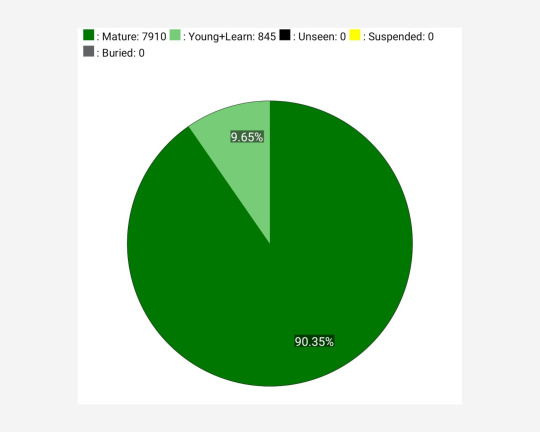
That one day in 2019 where I did not do my cards because I was seriously doubting whether I can actually stick with language learning this time around will forever haunt and inspire me to keep going everyday.
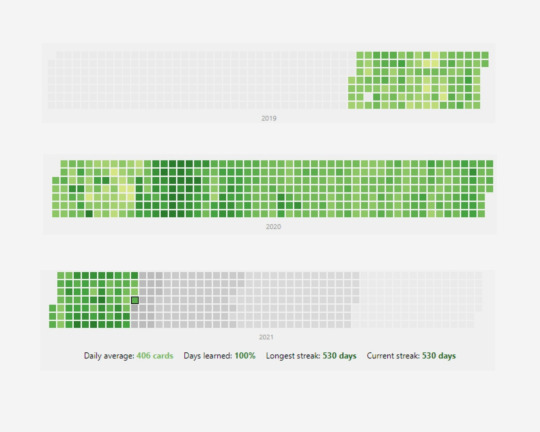
Workflow and Tips
You might be wondering, how do I have a lot of time? I started this whole endeavor in the middle of a pandemic, which eliminated the option of me going to a language school, and a slew of other things I were considering doing last year became impossible (and if anything, very scary to do in a pandemic). All I can say is that, things work out eventually if it is His will, and if I can learn a skill before everything properly settles back down again, then why not?
I wake up at 5 in the morning everyday to either do my Anki reps or read until the time when I need to get up and I listen to compressed audio throughout the day. The biggest tip is to switch the time you spend watching/reading in your native language to your target language instead. Listen to a podcast during your commute, watch an episode during lunch break, read before going to bed, do your Anki reps in the bathroom if you have to.
But, if you’re feeling burnt out, there is no reason for you to not take a break! I have been watching a lot of Among Us streams before bed, and I chat with my friends from time to time. Language learning is not a race.
More Stats
Here are a couple of grids of the kanji characters that I have encountered at least once in my immersion and how well I have answered them in my vocabulary/sentence cards.
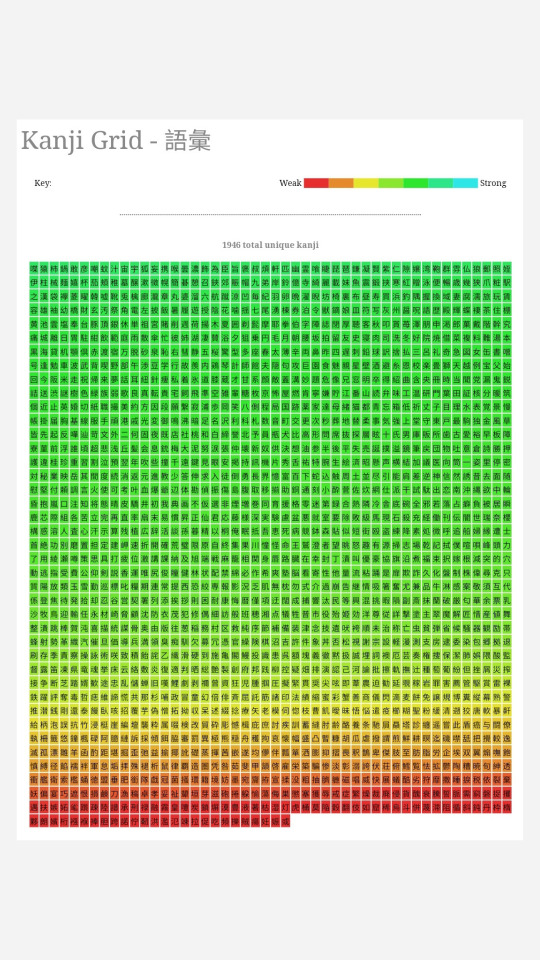
It's interesting that after almost 9000 words, I have yet to encounter every single character from the Remembering the Kanji 1 (RTK 1) book by James Heisig, which teaches you the most common use characters that are part of the 常用漢字. Which brings me to the question, was writing down every single character being taught in RTK worth it every time it came up in my reviews for the first 3-ish months I was reviewing them? Maybe, maybe not. It certainly removed my anxiety whenever looking at blocks of text in Japanese, but the longer I think about it, the more I feel I should have switched to Recognition RTK earlier. Still, being able to write in proper stroke order is cool I guess, and it also helps me when looking things up in the dictionary.
Here’s the same grid but in JLPT order:
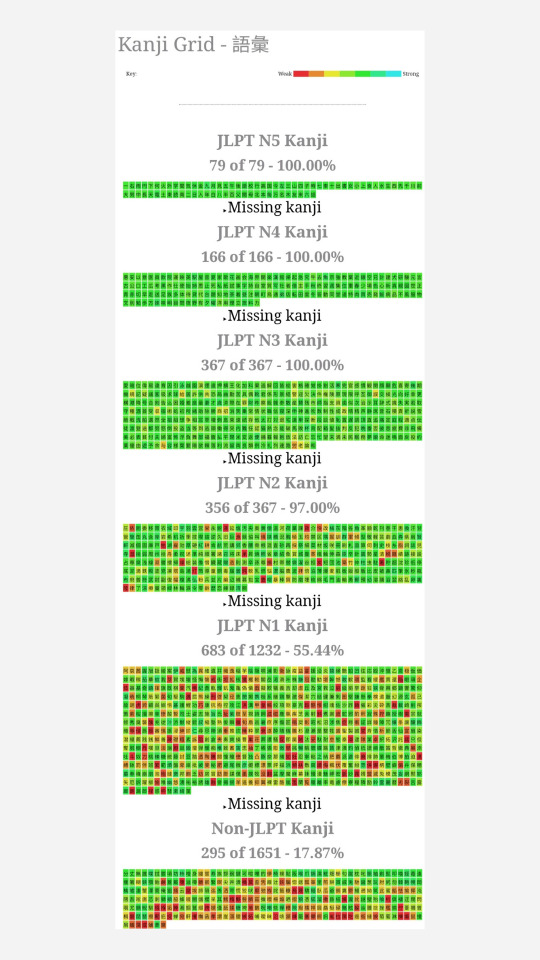
I clearly need to grind those N2 and N1 level cards! Speaking of which, I have apparently almost covered every single character that could possibly appear in the JLPT (except for the N1 which I have only covered half of) in just a year's time. If the JLPT word frequency lists I’m using are accurate, I have about 2,000 words more to go to to cover most vocabulary that could appear in the test. This makes the "10,000 sentences/words to fluency" argument a reasonable milestone to aim for for Japanese learners if said aim is only to pass the test. That said, 10,000 words is just that, a milestone. It's more akin to a comfortable level of comprehension, but not my own concept of fluency which is being able to read with ease, speak articulately, and write comfortably.
READING IMMERSION GRAPHS
My biggest motivation for tracking my stats is for the purpose of seeing whether my reading speed is improving over time. Reading speed is also easier to measure than listening comprehension which is kind of subjective, so I had a lot of fun making these. What I found is that for the first volume or chapter of whatever it is I’m reading, I always take the time to get used to the writing style of the author. My speed really improves whenever I keep reading the same topic over and over again. On the other hand and quite obviously, looking up many new words in a row and trying to parse sentences slows me down.
Manga: Reading Speed Progression per Volume
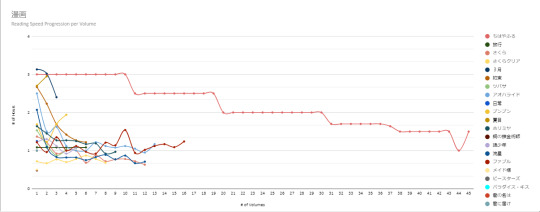
I clearly love ちはやふる and I am not ashamed to admit it.
I need to start reading longer manga. When I do, I’ll probably split this graph into less than and greater than 20 volumes. Imagine if I start reading something ridiculously long as 名探偵コナン or ワンピース, these graphs will start breaching the bounds of time and space.
Novels: Time Spent Reading per Chapter
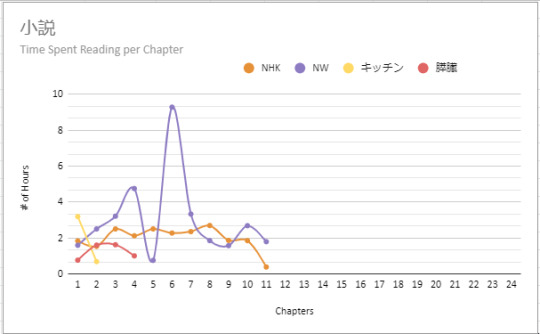
#neverforget the time I read chapter six of Norwegian Wood for 9 hours when it took me less than half that time in English RIP. Also, my interest in Kitchen plummeted LOL. Still planning to finish it don’t worry.
I also need to start branching away from manga and start reading more novels and light novels, too just so I can make more pretty graphs.
Visual Novels: Time Spent Reading and Daily Word Count
Also known as images that clearly show that I’ve already spent several days only reading the prologue of Island. I’m not sweating. 切那 needs to stop using words I don’t know in succession. More thoughts on this VN far into the future.
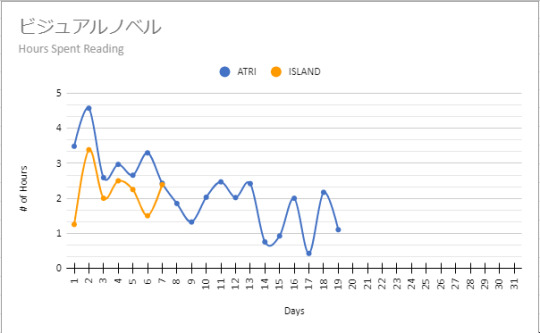

Thoughts on Immersion
I can’t really say anything else other that that it works for me, and needless to say if you’re considering this method, remember that the SRS is your friend but immersion should be your one true love.
Prior to all this, I couldn’t even read a sample paragraph from Genki without being confused to my very soul. Yes, I know, it’s embarrassing, but that’s the truth. I was way more scared of failing my Japanese classes than my actual thesis for my bachelors degree, I kid you not. I would quite literally spend all my free time in university trying to understand grammar, memorize vocabulary, and answer my workbook exercises with little to no success.
I tried so hard to get all the grammar “formulas” into my head for 1.5 years and it only brought me more confusion. I’m never going back to traditional classroom study for language learning, but I will still refer to grammar books when I need to, and not because I feel like I need to answer 4783342 different workbook exercises like my life depended on it.
I still can’t believe it, but with immersion this statement is actually true to a point, don’t try shadowing anime/or calling your boss anime language slurs, use your common sense:
study anime to understand Japanese > study Japanese to understand anime
Future Goals/Plans
2,200 immersion hours was my initial goal, but honestly I feel like that number could be much higher. There’s still a lot of stuff I don’t understand (news, politics, sciences, etc.), so I’ll make attempts to cover more of those things in my immersion.
I’ll continue reading more, because that’s a natural SRS in itself. Try to read longer manga, more novels, visual novels, and light novels, and maybe news articles.
I’ll try to mine as much “JLPT vocab” as I can before making any attempts at taking the JLPT. I noticed that a lot of the words I know don’t appear in the JLPT word lists as much, even though they appear a lot in media/daily conversation.
Continue mining all words I don’t know because all words are useful anyway. There is no such thing as useless words. I never really understood mining only “interesting words” or words that “pop up” in your immersion. As I said in my previous blog post, 美人局 is an interesting word and I certainly caught it being said in my immersion, but in the three languages I know, I wouldn’t know when I would be able to use such a word, as compared to something like ジャガイモ which is a significantly less interesting word, but is certainly useful to know.
_
I have managed to talk up a storm, but if you have any questions regarding my process or recommendations for new immersion material, please feel free to send an ask/reply to this post. I love hearing about other people’s language learning/immersion journeys.
See you on my next post!
#language learning#japanese language#language acquisition#study blog#langblr#studyblr#graphs#language immersion#japanese#visual novels#manga#novels#anime#dramas#movies#youtube#podcasts
125 notes
·
View notes
Text
Top 5 ANKI Add-ons For Medical Students
If you're a medical student, you've probably heard of ANKI. In fact, you're probably using it to study already. ANKI has been my most used app/resource throughout my first year of medical school and I would recommend it to everyone, whether they are studying medicine or not. One of the best things about this app is the huge number of free add-ons you can download to enhance and personalise your experience. In this post, I have listed my 5 favourite add-ons for ANKI and how I use them to make my studying more efficient and more fun.
NOTE: I have included links to the add-ons I have used, but these are not for the newest version of ANKI (i.e. ANKI 2.1). A quick Google search with bring up the newest versions.
1. Image Occlusion Enhanced
This is an absolute MUST have add-on for anyone studying a subject with many diagrams and/or tables. It allows you to cover the labels of a diagram or blank out individual cells of a table and convert them into individual flashcards. This makes it very easy to memorise detailed anatomical diagrams very quickly and was the main way that I learned anatomy this year.
2. Review Heatmap
This add-on has been a complete game changer for me in terms of keeping me motivated to do ANKI flashcards every day. Not only does it show you whether or not you have reviewed your cards on that day, but it gives you a visual representation of how many cards you have done per day over the last year. It can also be customised by changing the colour, which is always a fun way to make studying a little more interesting.
Usually I aim for around 100-200 reviews a day, but since its the summer holidays I've been giving myself a bit of a break!
3. Advanced Previewer
'Advanced Previewer' is an add-on that I didn't realise I needed until I discovered it and started using it, but has changed my ANKI experience so much! It allows you to preview all of the cards in a given deck at a glance rather than just one at a time. Total game-changer for learning information from cards in addition to reviewing them.
4. Right Hand Reviews with 'jkl'
Normally, ANKI allows you to use the keys '123' to note down how well you know a particular card. However, for right handed people (including myself) this can be quite inconvenient. The 'Right Hand Reviews' add-on allows you to use the keys 'jkl' for the same purpose!
5. Popup Dictionary
This is another add-on that I didn't realise I needed until I was introduced to it by one of my friends. It allows you to highlight a given word on a flashcard and see all the other cards that have the same word on them. This is a great way to form links between concepts and ideas to gain a stronger understanding of a topic.
If there are any ANKI add-ons you think I should try or that deserve to be in my top five, be sure to let me know in the comments or on Instagram.
Instagram | Tumblr | Blog | Etsy
2 notes
·
View notes